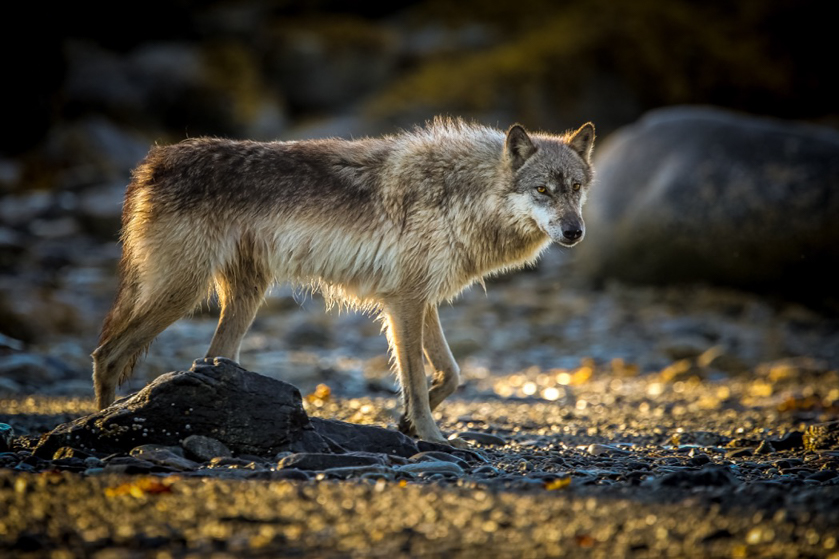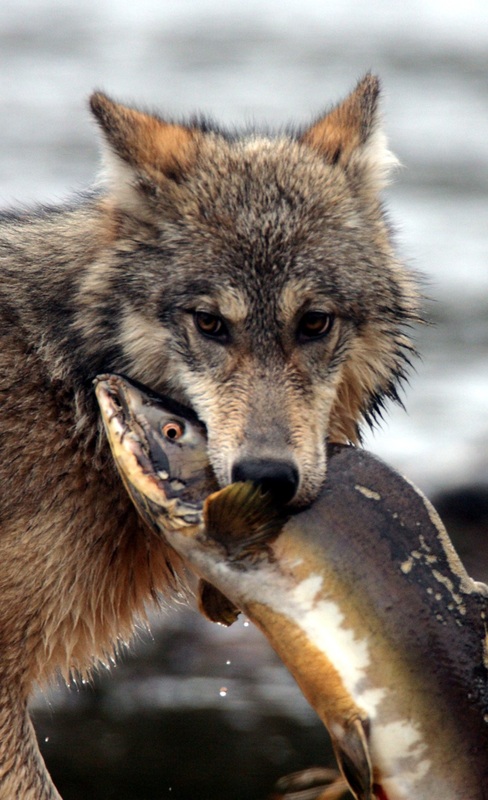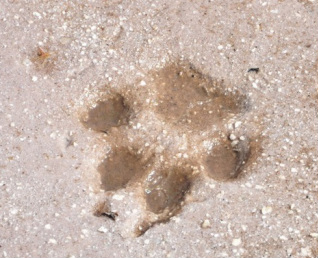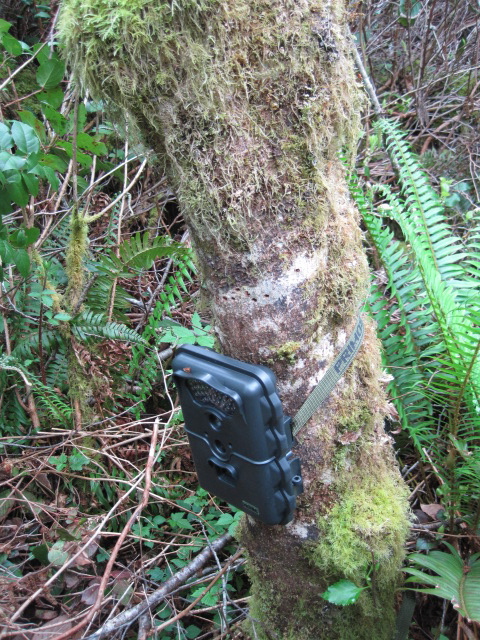Coastal wolf, coast wolf, grey wolf, timber wolf • Canis lupus
{Canis = dog, lupus = wolf}
|
Top left: coastal wolf on a beach in early morning. Photo by Erin Rechstiner. Right: coastal wolf with a freshly-caught pink salmon. Right and bottom left photos by Chris Darimont (raincoast.org). Below: photos by Kelly Fretwell (track) and Georgia Brander.
|
Identification
The coastal wolf is a genetically distinct population* of the grey wolf, which is found worldwide. The grey wolf generally looks similar to domestic sled dogs, but with a few differences: a larger head, longer legs, bigger feet, a straighter tail and a narrower chest. Weight and size can vary, as the species has adapted to a variety of habitats worldwide. The average length of a grey wolf is approximately 1.5 m. Males can be up to 70 kg, while females are smaller at about 50 kg. Its fur is thick, with a coarse outer layer and soft undercoat. The longer, thicker winter coat is shed in the spring, leaving a shorter summer coat which grows throughout the fall and winter. The fur is usually grey with some black flecks, with a lighter underside and legs. Some populations or even individuals will vary from this however: some may be nearly completely red, brown, white, or black, while others may have grey fur mottled with those colours. Coastal wolf differentiation: coastal wolves have shorter and coarser hair, grey fur tinged with red and brown, and a brown undercoat. They are generally smaller and have smaller skulls.
* Taxonomy: Grey wolf taxonomy in BC has not been formally resolved. There are currently two recognized subspecies: C. l. nubilus is used for wolves in coastal and southern BC, and C. l. occidentalis is used for the eastern and northern areas of the province. In recent years research by Raincoast Conservation Foundation's Dr. Chris Darimont and colleagues has determined that the wolves of coastal BC are more genetically distinct from each of the two subspecies than those subspecies are from each other. Three subspecies were recognized a few decades ago, but the most recent taxonomic revision grouped the coastal wolves with the nubilus subspecies.
Read more about this research here.
The coastal wolf is a genetically distinct population* of the grey wolf, which is found worldwide. The grey wolf generally looks similar to domestic sled dogs, but with a few differences: a larger head, longer legs, bigger feet, a straighter tail and a narrower chest. Weight and size can vary, as the species has adapted to a variety of habitats worldwide. The average length of a grey wolf is approximately 1.5 m. Males can be up to 70 kg, while females are smaller at about 50 kg. Its fur is thick, with a coarse outer layer and soft undercoat. The longer, thicker winter coat is shed in the spring, leaving a shorter summer coat which grows throughout the fall and winter. The fur is usually grey with some black flecks, with a lighter underside and legs. Some populations or even individuals will vary from this however: some may be nearly completely red, brown, white, or black, while others may have grey fur mottled with those colours. Coastal wolf differentiation: coastal wolves have shorter and coarser hair, grey fur tinged with red and brown, and a brown undercoat. They are generally smaller and have smaller skulls.
* Taxonomy: Grey wolf taxonomy in BC has not been formally resolved. There are currently two recognized subspecies: C. l. nubilus is used for wolves in coastal and southern BC, and C. l. occidentalis is used for the eastern and northern areas of the province. In recent years research by Raincoast Conservation Foundation's Dr. Chris Darimont and colleagues has determined that the wolves of coastal BC are more genetically distinct from each of the two subspecies than those subspecies are from each other. Three subspecies were recognized a few decades ago, but the most recent taxonomic revision grouped the coastal wolves with the nubilus subspecies.
Read more about this research here.
Habitat & Range
Coastal wolves are only found west of the Coast Mountain Range, in the remote temperate rainforest of coastal BC (the Great Bear Rainforest). This range includes the many islands and archipelagos on the coast, as they are very capable swimmers. There is some evidence that a similar difference exists between the wolves on the southeastern coast of Alaska and the interior wolves, meaning the subspecies identified by Darimont and colleagues may extend north of BC into the southeastern coast and islands of Alaska. The taxonomic differentiation of a few decades ago recognized the coastal wolves of BC, Washington, and Oregon as C. l. fuscus; if the basis of differentiation was the same as the recent study, the subspecies may have extended south of BC. The coastal Washington and Oregon populations are no longer present, however.
Similar Species
The coyote is quite a bit smaller, with a bushy tail, longer, pointed ears and a face shaped more like a fox.
Human Uses
Wolves are hunted for sport both in BC and elsewhere. This is a controversial subject for many reasons, not least of which is that while coastal wolves are not formally recognized as genetically distinct — either as a subspecies or as an "evolutionarily significant unit" — they are grouped together with the other subspecies which are more abundant. This means that they and their habitat are less likely to be granted adequate protection.
Intriguing Info
Coastal wolves have been described as marine mammals (even "sea wolves") as they rely heavily on marine resources such as salmon and seals. Their reliance on salmon is highest during the salmon spawning season in the fall. Coastal wolves are part of an ecosystem that has a strong land-sea connection: nutrients that salmon obtain when out at sea are brought to shores and riverbanks when salmon are removed from the water by predators such as coastal wolves. Leftover nutrients are taken up by a range of terrestrial organisms, from scavenging insects and small mammals to the nearby plants.
Coastal wolves are only found west of the Coast Mountain Range, in the remote temperate rainforest of coastal BC (the Great Bear Rainforest). This range includes the many islands and archipelagos on the coast, as they are very capable swimmers. There is some evidence that a similar difference exists between the wolves on the southeastern coast of Alaska and the interior wolves, meaning the subspecies identified by Darimont and colleagues may extend north of BC into the southeastern coast and islands of Alaska. The taxonomic differentiation of a few decades ago recognized the coastal wolves of BC, Washington, and Oregon as C. l. fuscus; if the basis of differentiation was the same as the recent study, the subspecies may have extended south of BC. The coastal Washington and Oregon populations are no longer present, however.
Similar Species
The coyote is quite a bit smaller, with a bushy tail, longer, pointed ears and a face shaped more like a fox.
Human Uses
Wolves are hunted for sport both in BC and elsewhere. This is a controversial subject for many reasons, not least of which is that while coastal wolves are not formally recognized as genetically distinct — either as a subspecies or as an "evolutionarily significant unit" — they are grouped together with the other subspecies which are more abundant. This means that they and their habitat are less likely to be granted adequate protection.
Intriguing Info
Coastal wolves have been described as marine mammals (even "sea wolves") as they rely heavily on marine resources such as salmon and seals. Their reliance on salmon is highest during the salmon spawning season in the fall. Coastal wolves are part of an ecosystem that has a strong land-sea connection: nutrients that salmon obtain when out at sea are brought to shores and riverbanks when salmon are removed from the water by predators such as coastal wolves. Leftover nutrients are taken up by a range of terrestrial organisms, from scavenging insects and small mammals to the nearby plants.
Left: a wolf cam strapped to a tree on Calvert Island. Wolf cams are motion activated and are intended to capture images like the night-time shot at right - although movements from other animals get captured as well. Video cameras are also used to observe wolf behaviour. This Globe and Mail article discusses the types of behaviours observed on camera and provides some video footage; these behaviours may also be observed on a Pacific Wild live camera.
Conservation:
Grey wolves are currently split into two subspecies, but there is evidence in recent years that coastal grey wolves constitute a third subspecies or 'evolutionarily significant unit'. Currently neither formally recognized subspecies is designated as at-risk by BC or COSEWIC. It is possible that if coastal wolves were assessed as a separate subspecies they may be given a different listing, as they face similar threats as grizzly bears: habitat loss, trophy hunting, and decreasing Pacific salmon stocks.
Grey wolves are currently split into two subspecies, but there is evidence in recent years that coastal grey wolves constitute a third subspecies or 'evolutionarily significant unit'. Currently neither formally recognized subspecies is designated as at-risk by BC or COSEWIC. It is possible that if coastal wolves were assessed as a separate subspecies they may be given a different listing, as they face similar threats as grizzly bears: habitat loss, trophy hunting, and decreasing Pacific salmon stocks.
|
Learn more about coastal wolves and the issues they face in these publications: • Lone wolf: Canada’s newest marine mammal • The Gray Wolves, Canis lupus, of British Columbia's Central and North Coast: Distribution and Conservation Assessment • The Gray Wolves (Canis Lupus) of British Columbia's Coastal Rainforests • The Last Wild Wolves (book not available online) |
|
References
Canis lupus Linnaeus 1758. In Klinkenberg, Brian. (Ed.). E-Fauna BC: Electronic Atlas of the Fauna of British Columbia. Lab for Advanced Spatial Analysis, Department of Geography, University of British Columbia, Vancouver. Accessed 02/07/2013.
Canis latrans Say, 1823. In Klinkenberg, Brian. (Ed.). E-Fauna BC: Electronic Atlas of the Fauna of British Columbia. Lab for Advanced Spatial Analysis, Department of Geography, University of British Columbia, Vancouver. Accessed 02/07/2013.
Darimont, C.T., and Paquet, P.C. (2000). The Gray Wolves (Canis lupus) of British Columbia’s
Coastal Rainforests: Findings from Year 2000 Pilot Study and Conservation Assessment. Raincoast Conservation Society. Victoria, BC.
Darimont, C., Genovali, C., and Paquet, P. Lone wolf: Canada’s newest marine mammal. (n.d.). Raincoast Conservation Foundation. Accessed 02/07/2013.
Darimont, C.T., and Paquet, P.C. (2002). The Gray Wolves, Canis lupus, of British Columbia's Central and North Coast: Distribution and Conservation Assessment. Canadian Field Naturalist. 116(3): 416-422.
Darimont, C. T., & Reimchen, T. E. (2002). Intra-hair stable isotope analysis implies seasonal shift to salmon in gray wolf diet. Canadian Journal of Zoology. 80(9), 1638–1642.
Grey wolf (Canis lupus). ARKive.org. Accessed 02/07/2013.
Muñoz-Fuentes, V., Darimont, C. T., Wayne, R. K., Paquet, P. C., & Leonard, J. A. (2009). Ecological factors drive differentiation in wolves from British Columbia. Journal of Biogeography. 36(8), 1516–1531.
Authors and editors of page
Kelly Fretwell and Brian Starzomski (2013).
Canis lupus Linnaeus 1758. In Klinkenberg, Brian. (Ed.). E-Fauna BC: Electronic Atlas of the Fauna of British Columbia. Lab for Advanced Spatial Analysis, Department of Geography, University of British Columbia, Vancouver. Accessed 02/07/2013.
Canis latrans Say, 1823. In Klinkenberg, Brian. (Ed.). E-Fauna BC: Electronic Atlas of the Fauna of British Columbia. Lab for Advanced Spatial Analysis, Department of Geography, University of British Columbia, Vancouver. Accessed 02/07/2013.
Darimont, C.T., and Paquet, P.C. (2000). The Gray Wolves (Canis lupus) of British Columbia’s
Coastal Rainforests: Findings from Year 2000 Pilot Study and Conservation Assessment. Raincoast Conservation Society. Victoria, BC.
Darimont, C., Genovali, C., and Paquet, P. Lone wolf: Canada’s newest marine mammal. (n.d.). Raincoast Conservation Foundation. Accessed 02/07/2013.
Darimont, C.T., and Paquet, P.C. (2002). The Gray Wolves, Canis lupus, of British Columbia's Central and North Coast: Distribution and Conservation Assessment. Canadian Field Naturalist. 116(3): 416-422.
Darimont, C. T., & Reimchen, T. E. (2002). Intra-hair stable isotope analysis implies seasonal shift to salmon in gray wolf diet. Canadian Journal of Zoology. 80(9), 1638–1642.
Grey wolf (Canis lupus). ARKive.org. Accessed 02/07/2013.
Muñoz-Fuentes, V., Darimont, C. T., Wayne, R. K., Paquet, P. C., & Leonard, J. A. (2009). Ecological factors drive differentiation in wolves from British Columbia. Journal of Biogeography. 36(8), 1516–1531.
Authors and editors of page
Kelly Fretwell and Brian Starzomski (2013).











